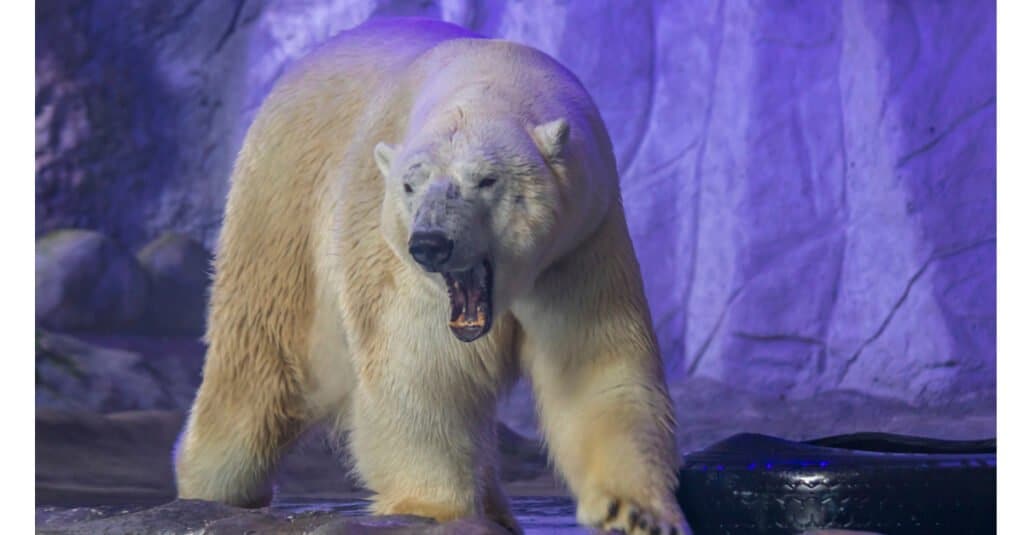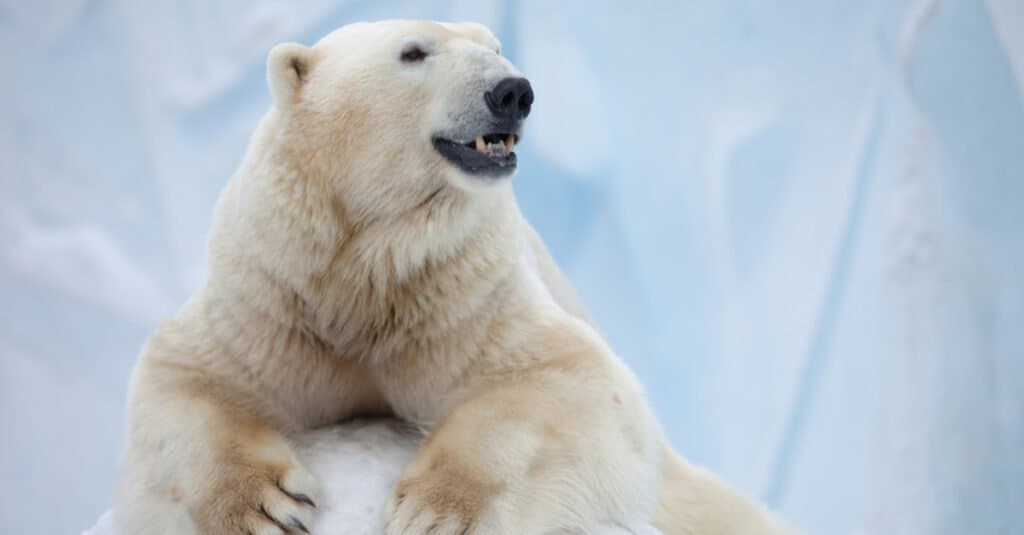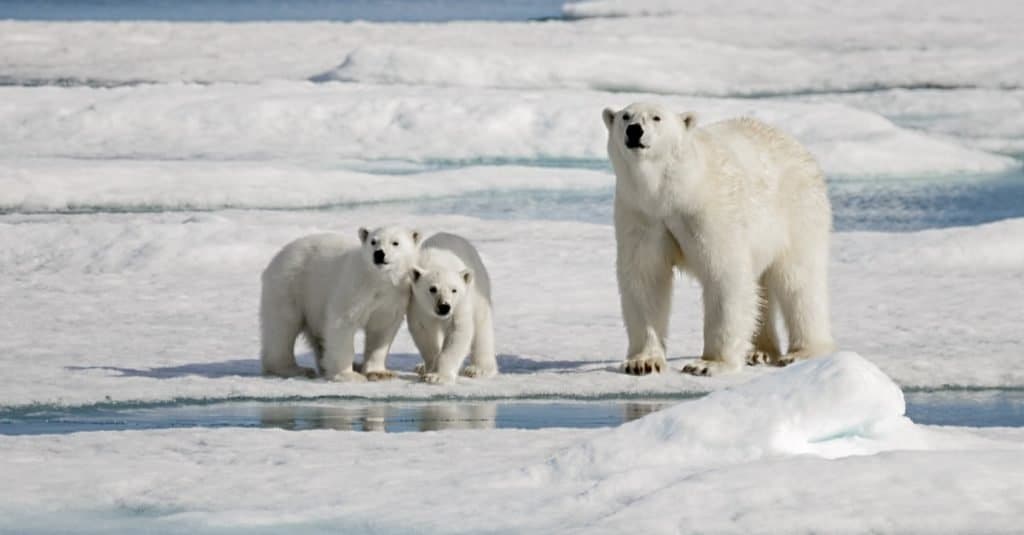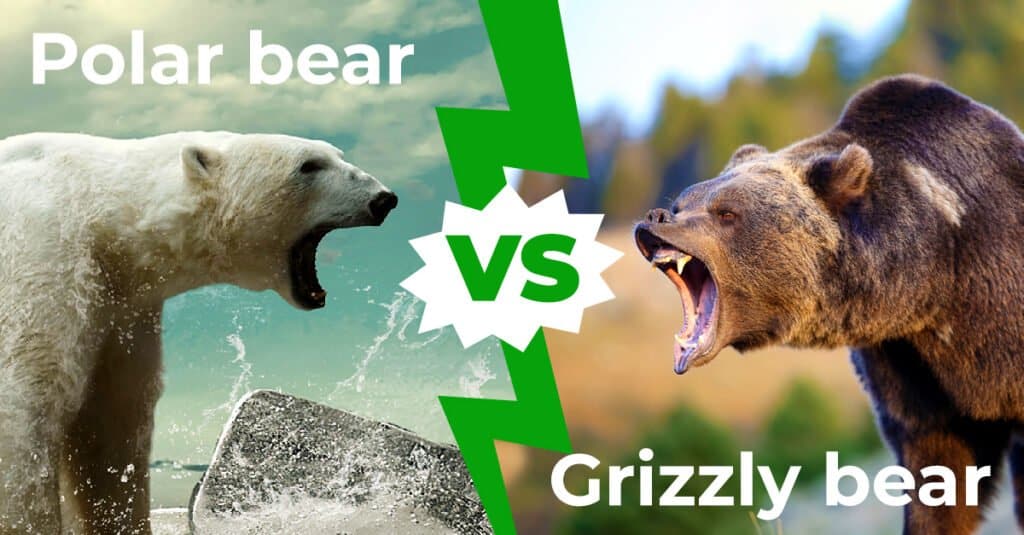Can you imagine coming across a paw print that is 12 inches wide? And you can tell it has sharp claws. If you are snowshoeing through Alaska and come across a 12 inch paw print, there is probably a polar bear nearby! But are polar bears dangerous?
Polar bears have four large paws with claws that can spread out to manage the weight of their muscular bodies. They spend much of their time in the cool arctic water and on sea ice floats, waiting to catch an unsuspecting seal. Polar bears are definitely dangerous to ringed seals and harbor seals, but are polar bears dangerous to humans?
If you saw one would they attack or walk away? Let’s find out!
What are Polar Bears?

The Polar Bear is a solitary animal that can not only run at speeds of up to 25mph but its strong ability to swim at 6mph makes it a true apex predator within its environment.
©Vaclav Sebek/Shutterstock.com
Polar bears are the largest of the bear family with the adult males getting to be as much as 1,500 lbs. They typically walk around on all fours, but they can stand up on their hind legs and be 10 feet tall!
Polar bears look all white with a black nose, but it turns out their fur is actually clear that reflects the white snow. Their skin is all black and sucks up the sun for warmth.
Are Polar Bears Dangerous?

Are polar bears dangerous? Yes! Polar bears have long sharp teeth and enormous paws with claws. Each paw is 12 inches across!
©imperio10/Shutterstock.com
Yes! Polar bears are dangerous. Polar bears and Grizzly bears are aggressive animals and have been known to attack and kill people.
When food is scarce, Polar bears have been witnessed hunting for humans as prey. Remember the 12 inch paw print, well that is from a 12 inch paw with sharp claws.
As powerful apex predator’s, polar bears pose a huge risk to human life and even property. Throughout the polar bear’s range, attacks on humans and property continue to rise and have through recent years. In fact, more than 20 direct attacks on people have been reported within polar bear range.
They also have very sharp, 2 inch canines and a total of 42 teeth. Their teeth are used to bite into blubbery seals and take huge slabs of meat off for their meals.
Ringed seals weigh around 160lbs but a hefty bearded seal can be 600lbs or more!
Where do Polar Bears Live?

Polar bears are marine mammals and can swim for long distances.
©Vladimir Gjorgiev/Shutterstock.com
Polar bears live in the cold arctic regions of Canada, Alaska, Russian, Greenland and few Norwegian islands. They are reliant on sea lions for food so they stay close to water at all times.
They are good swimmers and can spend so much time in the water they are considered a marine mammal.
There are only two national parks that you can find polar bears in, Bering Land Bridge National Preserve and Cape Krusenstern National Monument, both parks are in Alaska.
Do Polar Bears Attack People?

Tracks in the snow, droppings and old carcasses can be warnings that polar bears are nearby.
©Louise Ekeblad/Shutterstock.com
Yes, polar bears do attack people. According to a study of polar bear attacks, researchers found that between 2010 and 2014 there were 15 bear attacks, a huge increase to the average of 7-12 every ten years.
Scientists are studying if climate change is decreasing polar bears habitats and increasing human-bear conflicts. In the Norwegian islands of Svalbard there is a healthy polar population. People are required to carry firearms if they live the town, to protect them from being attacked.
The island is the site of an unfortunate Polar bear attack that resulted in the death of a 17-year-old boy. In 2011, Horatio Chapple, a teenager from Britain, was attacked and killed while on an month-long adventure organized by the British Schools Exploring Society (BSES).
A Polar bear snuck into the camp one night and attacked. It tore open one of the tents and bit one of the students on the head. Horatio was dragged out of the tent and killed by the Polar bear. Four other people were seriously injured during the bear attack.
An adult leader was finally able to shoot and kill the Polar bear. A tragic ending to a well-meaning adventure.
Do Polar Bears Kill People?

Climate change is affecting the ice caps and making the habitat for polar bears and other arctic animals smaller.
©Zhiltsov Alexandr/Shutterstock.com
Yes. Researches recorded 73 wild bear attacks between 1870-2014 with 63 resulting in injuries and 20 fatalities. Attacks since 2014 have also been recorded and seem to be increasing in frequency. Climate change is affecting the ice caps and making the habitat for polar bears and other arctic animals smaller.
In the summer of 2018 a dad was killed by a polar bear when he was out with his three children looking for Arctic tern eggs. The man put himself between the bear and his kids and told the children to run back to the boat and call for help.
They were out on a small island in the Canadian Hudson Bay, near the town of Arviat. The man was mauled by the polar bear and died on the scene. An adult nearby was able to shoot the polar bear, and the kids were not injured.
It is still statistically very rare for polar bears to attack and even more rare for people to be killed by polar bears, but polar bear-human conflicts are a growing concern.
Do Polar Bears Bite?
Yes, polar bears bite. If you get bit by a dog you are typically able to get away, but if you get bitten by a polar bear they are often looking for a meal or defending themselves.
What Should You Do if You Come Across a Polar Bear?

If you come across a polar bear (or polar bears) you should quietly back away and move away. Do not run or make sudden movements.
©Alexey Seafarer/Shutterstock.com
Since Polar bears have a limited range, you first need to be aware if you are in Polar bear territory. Polar bears stay by the coast so they have access to seals for food, so there is an increased risk along the coasts. If you do have to work or travel through polar bear country you need to stay alert.
Scan the horizon with binoculars periodically paying special attention to coastlines. Travel during the day if you can and travel in groups to deter bears.
It is not recommended to camp in a tent…at all. They recommend planning for shelters that are hard-sided like a cabin. Also keep a look out for those 12-inch paw prints! Tracks in the snow, droppings and old carcasses can be warnings that polar bears are nearby.
Carrying firearms and bear spray are also recommended. If you do see one (or more) back away slowly, do not turn and run and do not make any loud sudden movements.
Who Would Win in a Fight Between a Polar Bear and a Grizzly Bear?

If the two fiercest bears came face to face, who would win, read this article to find out who would win between a polar bear and a grizzly!
The photo featured at the top of this post is © imperio10/Shutterstock.com
Thank you for reading! Have some feedback for us? Contact the AZ Animals editorial team.






